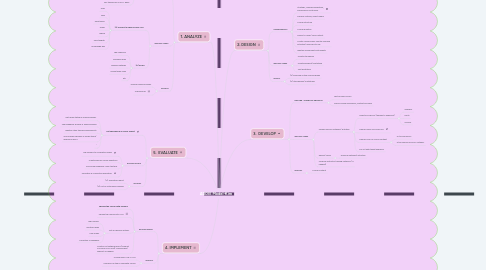
1. 1. ANALYZE
1.1. Analyze the CURRENT situation
1.1.1. PURPOSE/ GOAL of the training?
1.1.2. WHY are we doing the training?
1.1.3. What BEHAVIOURAL CHANGE is desired?
1.1.4. Will training ACTUALLY help?
1.2. ACTION STEPS
1.2.1. (a) Conduct a NEEDS ANALYSIS
1.2.1.1. Who
1.2.1.2. Why
1.2.1.3. What skills?
1.2.1.4. When
1.2.1.5. Where
1.2.1.6. How taught?
1.2.1.7. Knowledge gap
1.2.2. (b) AUDIT
1.2.2.1. The Audience
1.2.2.2. Business goals
1.2.2.3. Training methods
1.2.2.4. Media types used
1.2.2.5. etc
1.3. OUTPUT
1.3.1. Training Needs Analysis
1.3.2. Training Plan
2. 4. IMPLEMENT
2.1. ACTION STEPS
2.1.1. Sharing the course with learners
2.1.2. Upload the course onto LMS
2.1.3. Set up delivery options
2.1.3.1. Who enrols?
2.1.3.2. Duration given
2.1.3.3. Pass marks
2.1.3.4. Collection of feedback
2.1.4. Monitor for teething issues (conduct COURSE PILOT first). Provide help/ support as needed
2.2. OUTPUT
2.2.1. Course goes LIVE in LMS
2.2.2. Learners can take & complete course
2.3. HOW to implement
2.3.1. TRELLO software
2.3.2. Whiteboard & Post-it notes
2.3.3. Storyboarding
2.3.4. Learning Mgmt System (LMS)
3. 5. EVALUATE
3.1. Get FEEDBACK on every aspect
3.1.1. Met goals stated in Analysis phase?
3.1.2. Take feedback & place in Analysis phase
3.1.3. Identify other training requirements
3.1.4. Any possible changes in media types/ approach used ?
3.1.5. `
3.2. ACTION STEPS
3.2.1. Ask learners to complete surveys
3.2.2. Create specific survey questions
3.2.3. Encourage feedback: open text box
3.2.4. Formative & Summative evaluation
3.3. OUTPUT
3.3.1. (a) Evaluation report
3.3.2. (b) List of Actionable changes
4. 2. DESIGN
4.1. COMPONENTS
4.1.1. Strategy, Learning Objectives, Performance Outcomes
4.1.2. Delivery method, select media
4.1.3. Course structure
4.1.4. Course duration
4.1.5. Topics to cover/ core content
4.1.6. Create Lesson plans. Identify learning activities/ exercises to use
4.1.7. Identify assessment instruments
4.2. ACTION STEPS
4.2.1. Create Storyboard
4.2.2. Create blueprint/ prototype
4.2.3. Test prototype
4.3. OUPUT
4.3.1. (a) Overview of the Course design
4.3.2. (b) Storyboards/ Prototypes
5. 3. DEVELOP
5.1. NATURE : ITERATIVE PROCESS
5.1.1. Test for basic errors
5.1.2. Check course mechanics, content accuracy
5.2. ACTION STEPS
5.2.1. Prepare DRAFT materials/ activities
5.2.1.1. Select ELEMENTS (appeals to audience)
5.2.1.1.1. Graphics
5.2.1.1.2. Fonts
5.2.1.1.3. Colours
5.2.1.2. Check course NAVIGATION
5.2.1.3. Check FLOW of course content
5.2.1.3.1. Is it ENGAGING?
5.2.1.3.2. Is the course LENGTH suitable?
5.2.1.4. Try out with target audience
5.2.2. Revise/ refine
5.2.2.1. Produce materials/ activities
5.2.3. Produce Instructor training materials (if needed)
5.3. OUTPUT
5.3.1. Course content

